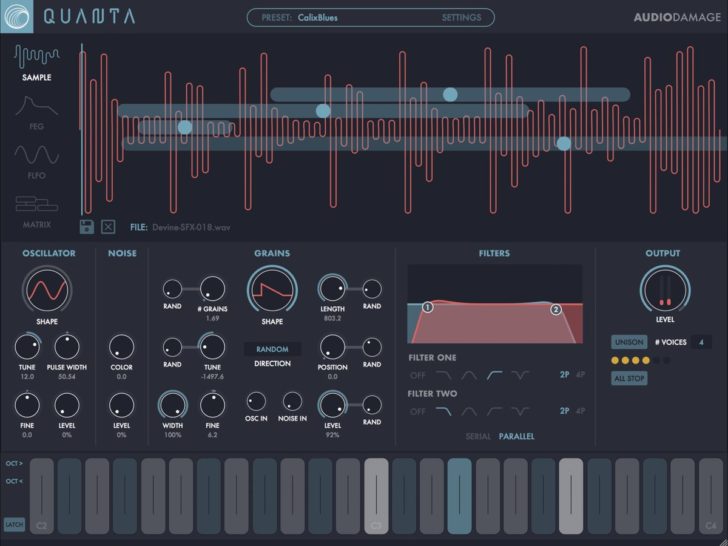Audio Damage has released Quanta for iOS, a new 10-voice granular synthesizer.
Quanta features a capable granular engine, a “sidecar” oscillator that can be used in addition to the granular source or instead of it, two multi-mode filters, a cross-platform preset system, and the ability to load AIFF, WAV, Ogg, FLAC, and MP3 format samples.
“Our goal was to try to make granular synthesis as easy to understand and use as subtractive,” notes AD’s Chris Randall, “and to make it as musical and playable as possible.”

Features:
- Multi-Format Sample Loader – Quanta can load AIFF, WAV, Broadcast WAV, FLAC, MP3, and Ogg in any sample rate, bit depth, and channel configuration.
- Grain Engine – Up to 100 simultaneous grains per voice, of up to 1 second long, with control over grain rate, pitch, direction, shape, length, panning, source position, and level.
- Sidecar Oscillator – Continuously variable wave shape, with pulse width modulation, and independent control over pitch (separate from grain engine.) Can be injected directly into grain engine.
- Noise Source – Noise source features a “color” control that affects tonal characteristics of the noise. Can be injected directly into grain engine.
- Dual Multi-Mode Filters – Filters can be used in serial or parallel modes, and include lowpass, highpass, bandpass, and notch in 2-pole and 4-pole configurations.
- Flexible Envelope Generator (FEG) x 4 -0 The four FEGs are arbitrary function generators, with up to 99 steps, curve and step level control, arbitrary loop points, and host tempo sync.
- Flexible Low-Frequency Oscillator (FLFO) x 2 – The pair of FLFOs utilize four controls (phase, shape, skew, and warp) to access a virtually limitless palette of waveforms, and feature host tempo sync and retrigger.
- Sample And Hold – The S&H mod source can sample noise (random) or any of the other mod sources, at either a user-defined rate or a musical division.
- Modulation Matrix – Every mod and MIDI source can be easily and simply assigned to any destination using the quick-access bi-polar modulation matrix. Touch a destination on the UI and the matrix automatically scrolls to the correct row.
- Tuning Tables And Global Tuning Offset – Re-tune Quanta to new intonations and temperaments using the open-source and easy-to-use TUN file format. A global tuning offset (default to A=440) allows you to easily retune the entire synth to match a different A frequency without using a tuning table.
- MPE (MIDI Polyphonic Expression) – Quanta understands both “legacy” MIDI and MPE. Use your Linnstrument, Roli Seaboard, Haken Continuum, or Madrona Labs Soundplane (among others) to directly access per-note pressure, pitch bend, and modulation.
- Per-Instance Settings – Quanta utilizes a per-instance customization method: set MPE mode, aftertouch smoothing, pitch bend range override, tuning table, and global tuning offset for each instance in your DAW.
- Factory Presets – Quanta comes with a substantial collection of factory content, including Designer Presets from Marcus Fisher, Joseph Fraioli, Chris Carter, and Richard Devine.
- Cross-Platform Preset Format – Quanta utilizes an XML-based preset manager, and stores the sample within the preset for easy asset management. Work between multiple systems without troubles, make a preset on your desktop machine and paste it to the iOS version with Handoff, easily share your creations with your friends, or make a preset bundle to sell, no asset management required.
- Fully Resizable Hi-Dpi/Retina GUI – Quanta’s vector-based GUI is resolution-agnostic, and displays the same on every system and resolution. Easily resize the UI (per instance) to match your visual needs, from postage stamp to poster-sized.
Note: Audio Damage says that Quanta will work on any iPad that can run iOS 11, but it is CPU intensive and they recommend using a 2017/2018 iPad or an iPad Pro.
Pricing and Availability
Quanta for iOS is available now for an introductory price of US $7.99 (through Sept. 1st.) Versions for macOS & Windows are also available.

I still do not understand what justifies the price difference between iOS and MacOS / Windows versions. Pass.
Me neither but who cares! Bought this already and it’s amazing even on my iPad mini2. Also have all that audio damage iOS plugins and they are some of the best sounding most solid apps for the iPad. I never buy vsts anyway as if you know how to use ableton properly you don’t need anything else. ( insert people disagreeing with me here )
I agree. Audio/midi routing on Mac with iPad you don’t need vsts or synths. iPad is powerful.
Why the confusion?
Developers say exactly why the iPad versions are so cheap.
On Windows, piracy is rampant, so it’s not uncommon to have most installs of an app to be cracks.
On iOS, that’s essentially non-existent.
Developers say this over and over – so why do people persist in saying otherwise?
It seems like people want a reason to justify piracy….
awesome glad I waited, more iPad sound making powers.
I love iOS (iPad) music making. I buy all of the audiodamage plugins. I pretty much abandoned music creation on PC and that’s largely due to the cost of most VSTs and DAW on windies. Have recently started buying VST plugins from a certain popular plugin site (I won’t name because that will sound like I’m advertising). I can’t put my finger on it but when I listen to a VST synth it sounds better for some reason. Shouldn’t be any reason for it as I’m not using a pro audio soundcard anymore. Just motherboard audio (albeit a more expensive motherboard).
why no midi learn though?